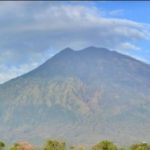New Zealand’s White Island volcano is showing increased seismic activity, putting recovery efforts on hold.
Authorities hoped they would be able to retrieve the nine people presumed dead on the island on Wednesday.
So far, six people have been confirmed dead in the tragedy. Another 29 are in intensive care with severe burns and one has been moved to Australia.
The volcano, also known as Whakaari, erupted on Monday when dozens of tourists were on the island.
“I’ve spoken to many of those involved in the operation and they are very, very eager to get back there, they want to bring people’s loved ones home,” Prime Minister Jacinda Ardern told reporters.
Meanwhile, the identification process and post mortem examinations of the victims are under way.
White Island is a popular tourist destination with frequent day tours and scenic flights available. At least 47 visitors from around the world were on the volcano crater at the time of two explosions in quick succession.
Police said that of the 30 injured, 25 are in a critical condition while the other five are classed as stable but serious.
Mr Nash explained the injuries to the survivors were so severe that some of them were unable to identify themselves.
“There are a number of people in hospital who cannot communicate, they have significant burns not only to skin but internal organs,” he told Radio New Zealand.
“We wish them the best but we’re not out of the woods yet, of that there’s no doubt.”
Dr Peter Watson, chief medical officer at New Zealand’s National Burns Unit said an estimated 1.2 million sq cm of replacement skin will be needed for the patients. An order has been placed from the US.
Several patients will be transferred to Australia by the Australian Defence Force using an intensive-care acceptable aircraft in the next 24-48 hours, Dr Watson said.
Where does donor skin come from?
Donated skin is vital for helping to save the life of a major burns patient. Skin is our largest organ and its main job is keeping dangerous viruses and bacteria out.
The damage caused by severe burns leaves patients at very high risk of infection. Donor skin is a short-term fix.
It comes from dead organ donors – in the same way as hearts, kidneys and corneas – and can be banked for several years.
The donor-skin aids healing, cuts the risk of infection and can reduce pain. The immune system is so weak after such an injury that rejection is not an issue.
A single major burns patient needs a lot of donor skin. New Zealand is treating 29 at the same time and has needed to turn to other countries for help.
New Zealand’s chief coroner on Wednesday declared the eruption a “mass fatality incident”.
Officials said they are working with disaster specialists and forensic experts to identify the victims so they can be returned to their families.
New Zealand police have now listed nine people as officially missing – though they say this is a partial list as they have not been able to speak to all the next of kin.
These are:
- Gavin Dallow (Australia)
- Jessica Richards (Australia)
- Krystal Browitt (Australia)
- Richard Elzer (Australia)
- Zoe Hosking (Australia)
- Karla Matthews (Australia)
- Julie Richards (Australia)
- Tipene Maangi (New Zealand)
- Hayden Inman (New Zealand)
At least five people on the list are believed to be dead or presumed dead based on relatives talking to media.
Tour guide Hayden Inman was identified as among the dead by his brother on Facebook.
Julie Richards and her daughter Jessica from Brisbane, Australia were identified as victims by a family spokesperson.
Adelaide father Gavin Dallow has been named as dead, with his stepdaughter Zoe Hosking presumed dead, according to media reports.
There is also a definitive list of all victims who are in hospital but police say they cannot release this for privacy reasons.



